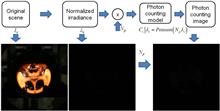For a Hanbury Brown and Twiss system, the influence of relative motion between the object and the detection plane on the resolution of second-order intensity-correlated imaging is investigated. The analytical results, which are backed up by experiments, demonstrate that the amplitude and mode of the object’s motion have no effect on the second-order intensity-correlated imaging and that high-resolution imaging can be always achieved by using a phase-retrieval method from the diffraction patterns. The use of motion de-blurring imaging for this approach is also discussed.
Ghost imaging and diffraction, inspired by the Hanbury Brown and Twiss effect, have potential in both classical and quantum optics regimes on account of their nonlocal characteristics and subwavelength resolution capability, and therefore have aroused particular interest. By extending the correspondence imaging scheme, we utilize the positive and negative intensity correlations in diffraction and perform subwavelength diffraction with pseudo-thermal light. In the experiment, a subwavelength (λ/2) resolution and a better signal-to-noise ratio (10.3% improvement) are simultaneously achieved. The scheme can be utilized as a complement to the existing ghost imaging scheme to improve image quality.
Quasi-single-photon sources are attracting a lot of interest in many fields at present; however, the knowledge is very poor about their performance. In this Letter, by using the standard Hanbury-Brown-Twiss measurement method, we investigate in detail the characteristics of the photons from an attenuated continuous single-mode red laser. For the first time to our knowledge we obtain the coincidence counting spectrum of a commercial single-photon source, which demonstrates that an appropriately attenuated continuous laser can be utilized as a quasi-single-photon source for general applications.
In this Letter, we propose a novel three-dimensional (3D) color microscopy for microorganisms under photon-starved conditions using photon counting integral imaging and Bayesian estimation with adaptive priori information. In photon counting integral imaging, 3D images can be visualized using maximum likelihood estimation (MLE). However, since MLE does not consider a priori information of objects, the visual quality of 3D images may not be accurate. In addition, the only grayscale image can be reconstructed. Therefore, to enhance the visual quality of 3D images, we propose photon counting microscopy using maximum a posteriori with adaptive priori information. In addition, we consider a wavelength of each basic color channel to reconstruct 3D color images. To verify our proposed method, we carry out optical experiments.













